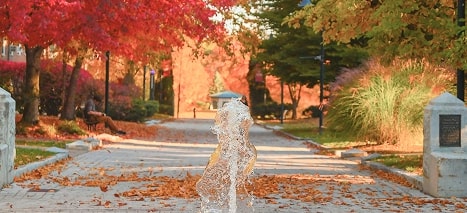Now the team is a mix of experienced and novice fencers, many of whom get a taste of the sport when they take fencing as a PE credit in A- or B-Term. Swelling to as many as 55 total students during those terms, the team practices three times a week throughout the school year on the basketball courts in Harrington. In C- and D-Terms, a core of about 15 students continues practicing their skills.
Students learn about the three main weapons of fencing. Foil is the traditional image of fencing where a thrusting motion is used to attack the chest area. Épée uses a thrusting motion, but with a larger target range. Saber movements involve a different motion, cutting, not thrusting, and are aimed at the top half of the body, says Carly Morrison, president of the fencing club.
People are often fascinated by fencing before they even get started with the weapons. “I first got started when I was 12 or so,” recalls Brown. “I don’t remember watching sword fights, but I remember going to museums and seeing swords and thinking they were very elegant.”
Morrison says she finds many fencers are simply drawn to the sport. Having never fenced before coming to WPI, Morrison says she was happy to find a sport that engaged her mind. “It’s a pairing of physical activity and mental activity,” she says. “You can’t think every single second because part of [fencing] is that you have to be relaxed and ready to respond. You have to think of what you want to do and react to achieve that goal.”
Brown agrees. The sport also requires stamina in both mind and body, says Brown. “There’s a lot of thinking about what to do and analysis of what your opponent is doing.” Physically, fencing activity is in short, intense bursts, so rapid action is imperative.
Morrison, who competes in the saber events, says she likes thinking about what her opponent will do, but all the attacking motions keep her in top form. “It’s really a workout,” she says, noting that fact surprises many people. Despite the intensity of the sport, the players are a fun-loving crew. “You want to enjoy what you’re doing,” she says.
At WPI, many freshmen catch their first sight of the club when fencers are waving their swords around in demonstrations at the annual activities fair. Without a doubt, it draws the attention of many students who wouldn’t normally consider fencing.
If students have never practiced fencing and want to try it, it’s a sport that can be learned quickly. “It’s a comprehensive sport,” says Brown. “If someone is talented, with coaching attention and regular practice, they can get from a college freshman with no experience to competition within three years.”
Anyone is welcome to watch a practice and can email fencing@wpi.edu for more information.
- BY JULIA QUINN-SZCESUIL


